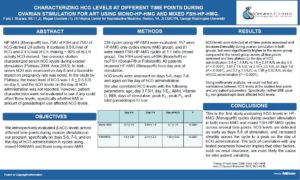hCG levels across different time points during ovarian stimulation are not associated with outcome in ICSI cycles.
Fady I. Sharara, MD (1,2), Megan Goodwin (1). (1) Virginia Center for Reproductive Medicine, Reston, VA, (2) George Washington University, Washington, DC.
 Objective: HP-hMG (Menopur®) has 75IU of FSH and 75IU of hCG-derived LH activity. It contains 9.9 IU/vial of hCG and 0.4 IU/vial of LH, making > 90% of its LH activity hCG-derived. Only one prior paper addressed the hCG levels during ovarian stimulation (Platteau 2004). In that study, hCG were assessed on day 6 and on the day of hCG administration in 121 VF and 237 ICSI cycles using HP-hMG, and cycles with the hCG levels > 2.0 IU/L on day 6, but not on day of hCG, had the highest live birth rate in ICSI but not in IVF cycles. It was unclear why this would be the case on day 6 and not on the day of hCG administration, nor why this would be the case in ICSI but not in IVF cycles. We therefore decided to correlate hCG levels across different time points during ovarian stimulation and outcome in our program.
Objective: HP-hMG (Menopur®) has 75IU of FSH and 75IU of hCG-derived LH activity. It contains 9.9 IU/vial of hCG and 0.4 IU/vial of LH, making > 90% of its LH activity hCG-derived. Only one prior paper addressed the hCG levels during ovarian stimulation (Platteau 2004). In that study, hCG were assessed on day 6 and on the day of hCG administration in 121 VF and 237 ICSI cycles using HP-hMG, and cycles with the hCG levels > 2.0 IU/L on day 6, but not on day of hCG, had the highest live birth rate in ICSI but not in IVF cycles. It was unclear why this would be the case on day 6 and not on the day of hCG administration, nor why this would be the case in ICSI but not in IVF cycles. We therefore decided to correlate hCG levels across different time points during ovarian stimulation and outcome in our program.
Design: Retrospective analysis.
Materials, Settings and Methods: 159 ICSI cycles using HP-hMG were evaluated: 105 were HP-hMG only cycles (mono hMG group), and 54 were mixed FSH-HP-hMG cycles at 1:1 ratio (mixed group). FSH used was uFSH (Bravelle®) or recFSH (Gonal-F® or Follistim®). All patients received HP-hMG (Menopur®) from day one of stimulation. hCG levels were assessed on days 5-6, days 7-8, and again on the day of hCG administration. Ongoing pregnancy (PR) was assessed by ultrasound at 6-7 weeks gestation.
Results: hCG levels were detected at all time points assessed and increased steadily during ovarian stimulation in both groups, but were significantly higher in the mono group compared to the mixed group across all time points assessed. The ongoing/delivered PR was 63.8% (67/105) in the mono-HP-hMG group, and 57.4% (31/54) in the mixed group (P=NS). hCG levels were not different between pregnant and non-pregnant cycles at all time points studied: 2.90 + 1.43 vs 2.76 + 1.55 IU/L, respectively (P=0.64) on day 5-6, 3.15 + 1.6 vs 3.19 + 2.80 IU/L (P=0.94) on days 7-8, and 3.1 + 1.48 vs 2.79 + 1.37 IU/L (P=0.25) on day of hCG administration. Unlike the prior study by Platteau, where 133 cycles had hCG levels between 1-2 IU/L, and 32 patients had hCG levels > 2.0 IU/L on day 6, we had XX and XX, respectively.
Conclusions: In contrast to the only published paper correlating hCG level on day 6 with outcome in ICSI cycles, we could not detect any differences in outcome on days 5-6, 7-8, or on the day of hCG administration. While there may be a trend towards higher PR with a higher hCG level on the day of hCG administration, larger numbers are needed to confirm or refute such an association. Our study is ongoing.
